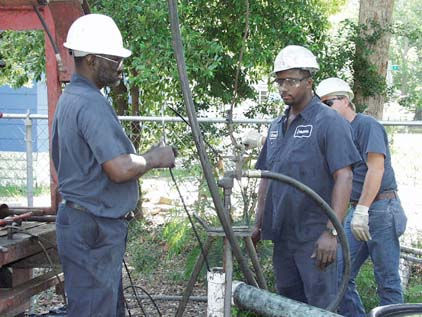The LORESCO Replaceable Deep Anode SystemTM allows for the inevitability of failure of deep anode systems to occur without the painful cost of drilling new bore holes. Since its introduction, the Loresco Replaceable Deep Anode SystemTM has been well received by the corrosion industry. Currently, there are thousands of systems operating in Japan, Canada, the United States, South America, North Africa, and the Middle East. Its design permits positive backfill placement in order to maximize the life of the anode system. The Loresco system is extremely versatile and systems have been designed ranging from 2 amps to 250 amps.
ADVANTAGES
-
Can be located in congested areas where surface ground beds pose geographic, topographic, or right-of-way problems.
-
Provides lower groundbed-to-earth resistance than shallow ground beds in areas of high resistivity surface soils.
-
Lowers anodic potential gradients to other structures more than shallow ground beds.
-
Provides better current distribution than shallow ground beds.
-
Virtually eliminates accidental damage which might occur to shallow ground beds by excavation and land cultivation.
-
Less effected by seasonal moisture variations, and is not subject to freezing.
-
Inspection, replacement or repair is simple and inexpensive.
PLANNING & DESIGN
Successful installations require advance planning. Once the design current output of the deep anode system has been determined, it is necessary to investigate the geology at the proposed installation location. With knowledge of the subsurface soils, the design engineer can estimate the depth of completion, determine the required hole diameter, and select the proper casing size and active length. Some of the sources for geological data include:
-
U.S. Geological Survey (USGS)
-
State Geologist
-
U.S. Department of Agriculture, Division of Soil Survey
-
Local Water Well Drillers
-
Oil, Gas, and Electric Companies with facilities in the area
-
Foundation Core Tests information
-
Electrical Logs for hydrocarbon wells
CASING SELECTION
The two factors which control the size and length of the casing within the active current discharge (perforated casing) zone are the soil resistivity and the current output of the system. The soil resistivity anticipated in the active zone can be estimated with knowledge of the geology. As the soil resistivity increases, the length of the active zone should also increase to minimize the final operating resistance of the system. The final operating resistance can be calculated using the Vertical Resistance Calculator. Also, the length of the active zone must increase as the required current output of the system increases to prevent operation problems such as gas blockage or soil drying.
The two most common casing sizes along with the recommended holes sizes and current outputs are shown in the following table:
MAXIMUM CURRENT OUTPUT
NOMINAL CURRENT OUTPUT
RECOMMENDED HOLE DIAMETER
CASING SIZE
6"
10"
0.33 A / ft
0.46 A / ft
Once the casing size and active length have been determined, the casing can be ordered with the following two options: A) Slotted casing covered by a metal outer membrane or open slotted casing and B) Casing end termination (PVC end cap, short PVC end adaptor with flow control, or standard steel lead with flow control).
CASING SPECIFICATION
All casings are schedule 40 PVC with cement joint, belled ends.
6" casing (6.625" O.D.) contains 224 - 0.75" x 5.5" slots per 20' section.
For maximum strength each row of slots is offset from the previous row and parallel with the centerline of the pipe.
ANODE SELECTION
The most commonly used anodes in LORESCO Replaceable Deep Anode SystemsTM are center-tapped graphite anodes or mixed-metal oxide anodes.
BACKFILL SELECTION
LORESCO type SC.3® carbon backfill is recommended for Replaceable Deep Anode SystemsTM. For high current output or small diameter anodes, LORESCO type SC.3® is the backfill of choice. LORESCO type SC.3® will not contaminate underground aquifers as indicated by NSF Certification to Standard 60. The quantity of LORESCO backfill required can be determined using the Weight Calculator.
INSTALLATION
-
Once the design (drilled hole size, casing selection, anode selection) is finished, a driller is procured. Installation generally requires only normally available drilling apparatus and skilled personnel who are knowledgeable in the installation of replaceable deep anode systems.
-
Once the hole has been drilled and electrically logged, casing installation proceeds. The steel lead is lowered, followed by the perforated anode section, and solid PVC plastic pipe is added until the proper depth is achieved.
-
At this point, Loresco Backfill is applied to the outside of the casing, followed by the addition of the anodes and Loresco Backfill on the inside of the casing.
-
Installation is essentially complete except for ground level work, which varies from site to site.
REPLACEMENT
Replacement is a simple process. Small equipment has been assembled which allows for the fluidization of the LORESCO Backfill around the old anodes. Once the casing has been cleared of all anode debris, new anodes are lowered and the LORESCO Backfill is allowed to settle. Some new backfill will be required. Replacement averages approximately eight hours from start to finish and requires little equipment and normally two men.

SUMMARY
The actual system being replaced in this demonstration is a replaceable deep anode design that has been in use since 1971. The design calls for a hole fully cased with non-metallic casing materials.
The rejuvenation shown in the sequence of pictures was started at 8:30 A.M. June 20, 2000. The replacement was finished at 1:30 P.M. the same day. The "new" system was re-energized the next day. The resistance was 0.9 ohm. The resistance in 1977 was 0.9 ohm.
The work on June 20 was the second replacement of this site. The system is 23 years old with a new anode.
The cost to make this system replaceable is the price of the non-metallic casing. The total cost of the non-metallic casing of this deep anode system would be USD $866.25.
For full catalog information please contact us. To discuss your upcoming deep anode system installation, call 601-544-7490


























